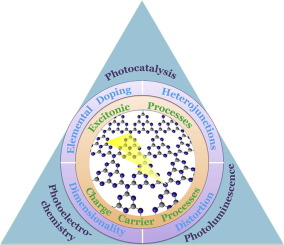当前位置:
X-MOL 学术
›
Mater. Today
›
论文详情
Our official English website, www.x-mol.net, welcomes your feedback! (Note: you will need to create a separate account there.)
Photoresponsive polymeric carbon nitride-based materials: Design and application
Materials Today ( IF 24.2 ) Pub Date : 2019-03-01 , DOI: 10.1016/j.mattod.2018.05.001 Hui Wang , Xiaodong Zhang , Yi Xie
Materials Today ( IF 24.2 ) Pub Date : 2019-03-01 , DOI: 10.1016/j.mattod.2018.05.001 Hui Wang , Xiaodong Zhang , Yi Xie

|
Abstract Recently polymeric carbon nitride-based materials have attracted tremendous attention for their outstanding photoresponsive properties, promising their great potential in various photoexcitation-related applications such as photocatalysis, photoelectrochemistry, photoluminescence, etc. On the basis of the understanding of the photoexcitation processes and structural features in the intriguing polymeric system, enormous efforts have been devoted to the optimization of photoresponsive performance via structure engineering, leaving various strategies for gaining efficient photoresponsive applications. In this review, we summarize recent advances in the exploitation of photoresponsive polymeric carbon nitride-based materials, highlighting the unique photoexcitation processes involved therein. We review the universal optimization strategies for the design of advanced photoresponsive materials, providing insights into the relationships between structural factors and photoexcitation processes in polymeric carbon nitride-based materials. Then photoresponsive applications and the involved functional mechanisms of polymeric carbon nitride-based materials are discussed. We conclude the review with a brief discussion of the future challenges and opportunities for the developments of polymeric carbon nitride-based materials.
中文翻译:

光响应聚合氮化碳基材料:设计与应用
摘要 近年来,聚合氮化碳基材料因其优异的光响应性能而备受关注,有望在光催化、光电化学、光致发光等各种与光激发相关的应用中发挥巨大潜力。由于具有迷人的聚合物系统的特征,人们付出了巨大的努力通过结构工程优化光响应性能,从而为获得有效的光响应应用留下了各种策略。在这篇综述中,我们总结了光响应聚合氮化碳基材料开发的最新进展,重点介绍了其中涉及的独特的光激发过程。我们回顾了先进光响应材料设计的通用优化策略,提供了对聚合氮化碳基材料中结构因素与光激发过程之间关系的见解。然后讨论了光响应应用和聚合氮化碳基材料的相关功能机制。最后,我们简要讨论了聚合氮化碳基材料发展的未来挑战和机遇。
更新日期:2019-03-01
中文翻译:

光响应聚合氮化碳基材料:设计与应用
摘要 近年来,聚合氮化碳基材料因其优异的光响应性能而备受关注,有望在光催化、光电化学、光致发光等各种与光激发相关的应用中发挥巨大潜力。由于具有迷人的聚合物系统的特征,人们付出了巨大的努力通过结构工程优化光响应性能,从而为获得有效的光响应应用留下了各种策略。在这篇综述中,我们总结了光响应聚合氮化碳基材料开发的最新进展,重点介绍了其中涉及的独特的光激发过程。我们回顾了先进光响应材料设计的通用优化策略,提供了对聚合氮化碳基材料中结构因素与光激发过程之间关系的见解。然后讨论了光响应应用和聚合氮化碳基材料的相关功能机制。最后,我们简要讨论了聚合氮化碳基材料发展的未来挑战和机遇。



























 京公网安备 11010802027423号
京公网安备 11010802027423号